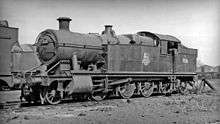GWR 7200 Class
|
7248 is a converted 42xx class no.4249, rebuilt with a 5275 front end. 7248 is seen here fitted with the 'Coal Scuttle' Bunker. | |||||||||||||||||||||||||||||||||||||||||||||
| |||||||||||||||||||||||||||||||||||||||||||||
| |||||||||||||||||||||||||||||||||||||||||||||
| |||||||||||||||||||||||||||||||||||||||||||||
| |||||||||||||||||||||||||||||||||||||||||||||
The Great Western Railway (GWR) 7200 Class is a class of 2-8-2T steam locomotive. These engines are the holders of several records:[1] they were the first engines with a 2-8-2T wheel arrangement built in Britain, the only 2-8-2Ts to be built in Britain, and were the largest tank engines to run on the Great Western Railway.[1]
Rebuild and operation
Originally the 4200 class and 5205 class 2-8-0T were introduced for short-haul Welsh coal traffic, but the Stock Market Crash of 1929 saw coal traffic dramatically fall. Built specifically for the short runs of heavy trains in the South Wales Coalfield, Charles Collett took the agreed decision to rebuild some of them with an extended coal carrying capacity by adding 4 feet (1.22 m) to the frames, requiring the addition of a trailing wheel set, making them 2-8-2T.[2]
With the work carried out at Swindon Works, the first to be converted was 5275 (lot 266), which returned to traffic numbered 7200 in August 1934. An official photograph of the prototype was taken on the 27th July 1934 at the usual site outside 'A Shop' for engine pictures. Nos. 5276–94 were similarly rebuilt between August and November 1934, becoming 7201–19, and nos. 7220–39 were rebuilt from 5255–74 between August 1935 and February 1936; with both batches, the rebuilding was not in numerical order, but the new numbers were in the same sequence as the old. Nos. 7240–53, rebuilt August 1937–December 1939, were selected at random from locomotives numbered in the 42xx series.[3]
The final batch of the class were later fitted with newly developed 'Coal Scuttle' bunkers. These bunkers consisted of a higher rivet line increasing the water capacity up to a total of 2,700 gallons allowing the locos to travel longer distances. The bunker was also designed to facilitate the movement of the coal towards the hatch in the cab, however ‘scuttle bunkers’ would only carry 5 tonnes of coal instead of 6. No.7200 is the only surviving loco of the class to carry one of these unique bunkers.
The 54 rebuilt locos found work in most parts of the GWR system, where their great weight 92 long tons 12 cwt (207,400 lb or 94.1 t) was allowed, although the rebuilt chassis length did get them banned from certain goods yards. Many found work in the home counties, deployed on iron ore and stone trains from Banbury.[4]
Withdrawal
The first member of the class to be withdrawn was number 7241 in November 1962, whilst the last four engines in traffic served until June 1965. As the majority of the class were still allocated to operations associated with the South Wales Coalfield, a majority were sent to Woodham Brothers scrapyard in Barry, Vale of Glamorgan. No. 7226 was scrapped there in 1965.[1]

Preservation
Three locomotives survive, all recovered from Woodham Brothers, though none have been restored:
- No. 7200: recovered in September 1981, under restoration at the Buckinghamshire Railway Centre by the 7200 Trust. No. 7200 is the only surviving locomotive to carry the unique 'coal scuttle' bunker which enabled it to have a greater water carrying capacity than the rest of the class with 'converted' bunkers. On 12 December 2006, the restored rolling chassis of No. 7200 left the former iron foundry (J Shop) which made the loco the last Great Western locomotive to receive attention at the historic Swindon Works.
- No. 7202: recovered in April 1974, under restoration at Didcot Railway Centre
- No. 7229: recovered in October 1984, under restoration at the East Lancashire Railway
Models
In 2012, Hornby released models of the 7200 class in both BR black and GWR green. [5]

References
- 1 2 3 Whitehurst, Brian (1973). Great Western engines, names, numbers, types, classes: 1940 to preservation. Oxford: Oxford Publishing Company. pp. 65–66, 103. ISBN 0-902888-21-8. OCLC 815661.
- ↑ "7202 - 2-8-2T". Didcot Railway Centre.
- ↑ le Fleming, H.M. (February 1962). White, D.E., ed. The Locomotives of the Great Western Railway, part nine: Standard Two-Cylinder Classes. RCTS. pp. J45–J46.
- ↑ Quainton Railway Society. "GWR 72XX Class 2-8-2T No. 7200". Buckinghamshire Railway Centre.
- ↑ "National Model Rail Database". National Model Rail. Retrieved 13 September 2015.
External links
| Wikimedia Commons has media related to GWR 7200 Class. |
